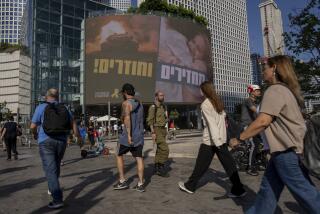Can a Dying Boy’s Image Be the Catalyst for Peace?
As the latest cycle of bloodshed continues unabated in the Israeli-occupied territories, one horrifying image has emerged as symbolic of the climate of utter despair and hopelessness that permeates the daily lives of Palestinians. When a news video camera captured the last few moments of 12-year-old Mohammed Durra’s short life, the faceless victims of the past few week (more than 60 Palestinians killed and 1,800 wounded) suddenly came to life.
The unfolding tragedy seemed to carry more meaning when viewers across the globe saw little Mohammed, his face contorted in terror as he clung desperately to his father as bullets fired by Israeli soldiers whizzed past. Subsequent images showed the child slumped lifeless in his wounded father’s lap. Rarely has the face of human tragedy been captured with such poignancy and raw emotion.
This indelible image will not soon be erased from our collective memory. Mohammed Durra was not the first victim of the Israeli-Palestinian conflict, nor, sadly, will he be the last. His tragic claim to fame is that a camera happened to capture the last few, terrifying moments of his life.
Nevertheless, his story must be told. Mohammed was the second child of Palestinian refugees from the 1948 war. His grandparents were driven from their farm in the center of the country to the Gaza Strip, the 30-mile sliver of land that is home to 1.2 million Palestinians and several thousand illegal Israeli settlers. He was in the fifth grade, and he lived in the dusty Bureij refugee camp, in a small concrete home.
By all accounts, he was a bright and engaging child, adored by classmates and teachers alike. According to his mother, Amal, Mohammed enjoyed swimming, reading, and playing with his pet birds (a gift from one of his teachers) and his cat. On that fateful Saturday, Mohammed was on an excursion with his father shopping for a used car when they stumbled into an area where Palestinian demonstrators were being fired upon by Israeli soldiers.
On the film taped by a French crew, we watch as they crouch behind a small barrel next to a concrete wall. We see his father, Jamal, raise his hand in the direction of the shooting, begging the Israeli soldiers to stop, “for the sake of the child.” Then, after the fatal bullets strike the young boy and he lies motionless, we hear the horrifying screams in Arabic from the vicinity of the camera: “The boy is dead! The boy is dead!” Then the video ends.
We learn later that Mohammed was struck by four bullets, his father by even more. We also learn that one ambulance driver who tried to rescue the pair was shot and killed, and another one wounded. But it is the image of Mohammed that we remember.
Before this image, Palestinians have remained, to many, a faceless mass devoid of individual identities. The images that often spring to mind are those of somber refugees trudging through unsanitary shanty towns or rock-wielding demonstrators wrapped in kaffiyehs.
Why, then, has the unforgettable image of Mohammed Durra struck such a sensitive chord among a public that has grown accustomed to images of on-screen violence? Perhaps it was the universality of the theme: an innocent child, stranded in no-man’s land; a helpless father, trying desperately to shield his son from a hail of bullets. On a basic level, the image represents the darkest manifestation of a universal parental nightmare: the inability to protect one’s own child.
On a global scale, international crises are often defined by a distinct image. In Vietnam, it was the portrait of a young girl fleeing through the streets, naked and crying, that helped solidify opposition to the war among large segments of the American public. In Beijing, it was the lone protester standing in front of a column of tanks in Tiananmen Square that captured the sympathy of the international community.
If the current bloodshed serves as a catalyst for finally achieving a just and lasting peace, as some have hoped, then “the picture” (and the human tragedy it encompasses) may well be remembered as a watershed event. And if any lesson is to be gleaned from this tragic drama, hopefully it will be that Palestinians are not merely anonymous statistics devoid of identity or meaning. They are men, women and children. They have dreams and aspirations of freedom. They are not killed by ambiguous “cross-fire” but by real bullets fired by real people who must be held accountable. And they have names like Mohammed Durra, 12 years old, from Gaza.
More to Read
Sign up for Essential California
The most important California stories and recommendations in your inbox every morning.
You may occasionally receive promotional content from the Los Angeles Times.










